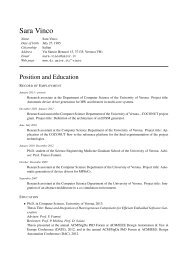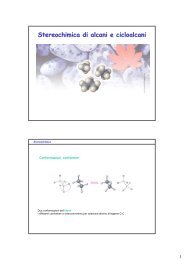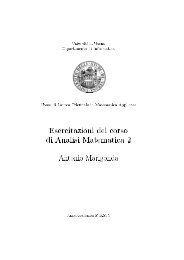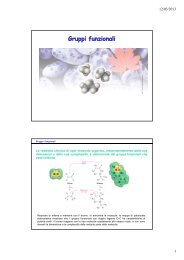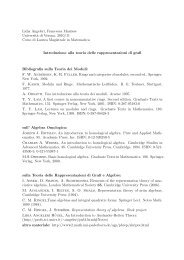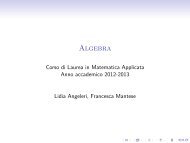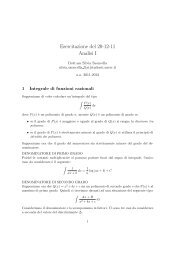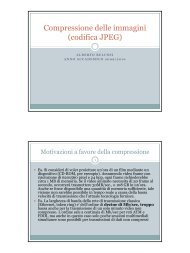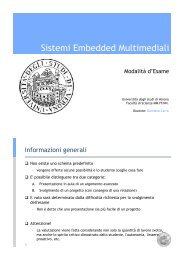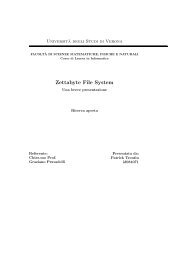You also want an ePaper? Increase the reach of your titles
YUMPU automatically turns print PDFs into web optimized ePapers that Google loves.
CAPITOLO 5<br />
Lezione del giorno martedì 13 ottobre 2009 (1 ora)<br />
Ancora sul calcolo di lim<strong>it</strong>i e topologia<br />
Esercizio 5.1. Si studi l’esistenza dei seguenti lim<strong>it</strong>i, e in caso affermativo li si calcoli:<br />
1. lim<br />
(x,y)→(1,0)<br />
y 2 log x<br />
(x − 1) 2 + y 2 2. lim<br />
(x,y)→(0,0)<br />
sin(x 2 + y 2 )<br />
x 2 + y 2<br />
sin(x<br />
3. lim<br />
(x,y)→(0,0)<br />
2 + y2 )<br />
x2y2 + y4 x<br />
4. lim<br />
(x,y)→(0,0)<br />
3 + x sin 2 (y)<br />
x2 + y2 xy(x<br />
5. lim y arctan(y/x) 6. lim<br />
(x,y)→(0,0) (x,y)→(0,0)<br />
2 − y2 )<br />
x2 + y2 xy<br />
7. lim <br />
(x,y)→(0,0) x2 + xy + y2 xyz<br />
8. lim<br />
(x,y,z)→(0,0,0) x2 + y2 (x<br />
9. lim<br />
|(x,y,z)|→+∞<br />
2 + y2 ) 2<br />
x2 + z2 <strong>10</strong>. lim<br />
|(x,y,z)|→+∞<br />
11. lim<br />
|(x,y,z)|→+∞ x4 + y 2 + z 2 − x + 3y − z 12. lim<br />
|(x,y,z)|→+∞ x4 + y 2 + z 2 − x 3 + xyz − x + 4<br />
Svolgimento.<br />
(1) Si trasli il problema in (0, 0) e si usi il lim<strong>it</strong>e fondamentale del logar<strong>it</strong>mo. Il lim<strong>it</strong>e è 0.<br />
(2) Si passi in coordinate polari, il lim<strong>it</strong>e è 1.<br />
(3) Si raccolga y 2 al denominatore e si passi in coordinate polari osservando che il dominio eslude l’asse<br />
y = 0. Il lim<strong>it</strong>e è +∞.<br />
(4) Si ricordi il lim<strong>it</strong>e fondamentale del seno al numeratore, e poi si passi in coordinate polari. Il lim<strong>it</strong>e è 0.<br />
(5) Si usi la maggiorazione arctan α ≤ π/2. Il lim<strong>it</strong>e è 0.<br />
(6) Si passi in coordinate polari, il lim<strong>it</strong>e è 0.<br />
(7) Si passi in coordinate polari. Si osservi che per nessun valore di θ il denominatore si annulla. Il lim<strong>it</strong>e<br />
è 0.<br />
(8) Si consideri il modulo della funzione. Ricordando che x 2 +y 2 ≥ 2|xy| si conclude che esso è maggiorato<br />
da |z|/2. Il lim<strong>it</strong>e è 0.<br />
(9) Si verifichi il lim<strong>it</strong>e sulle curve (t, 0, 0) e (0, 0, t). Il lim<strong>it</strong>e non esiste.<br />
(<strong>10</strong>) Si verifichi il lim<strong>it</strong>e sulla curva (t, t, t) e (t −1 , t, t −1 ). Il lim<strong>it</strong>e non esiste.<br />
(11) Si scriva la funzione come somma di tre funzioni di una sola variabile. Tali funzioni sono tutte inferiormente<br />
lim<strong>it</strong>ate e tendono a +∞ se la loro variabile tende a ±∞. Se |(x, y, z)| → +∞, almeno una<br />
17<br />
1<br />
xz



